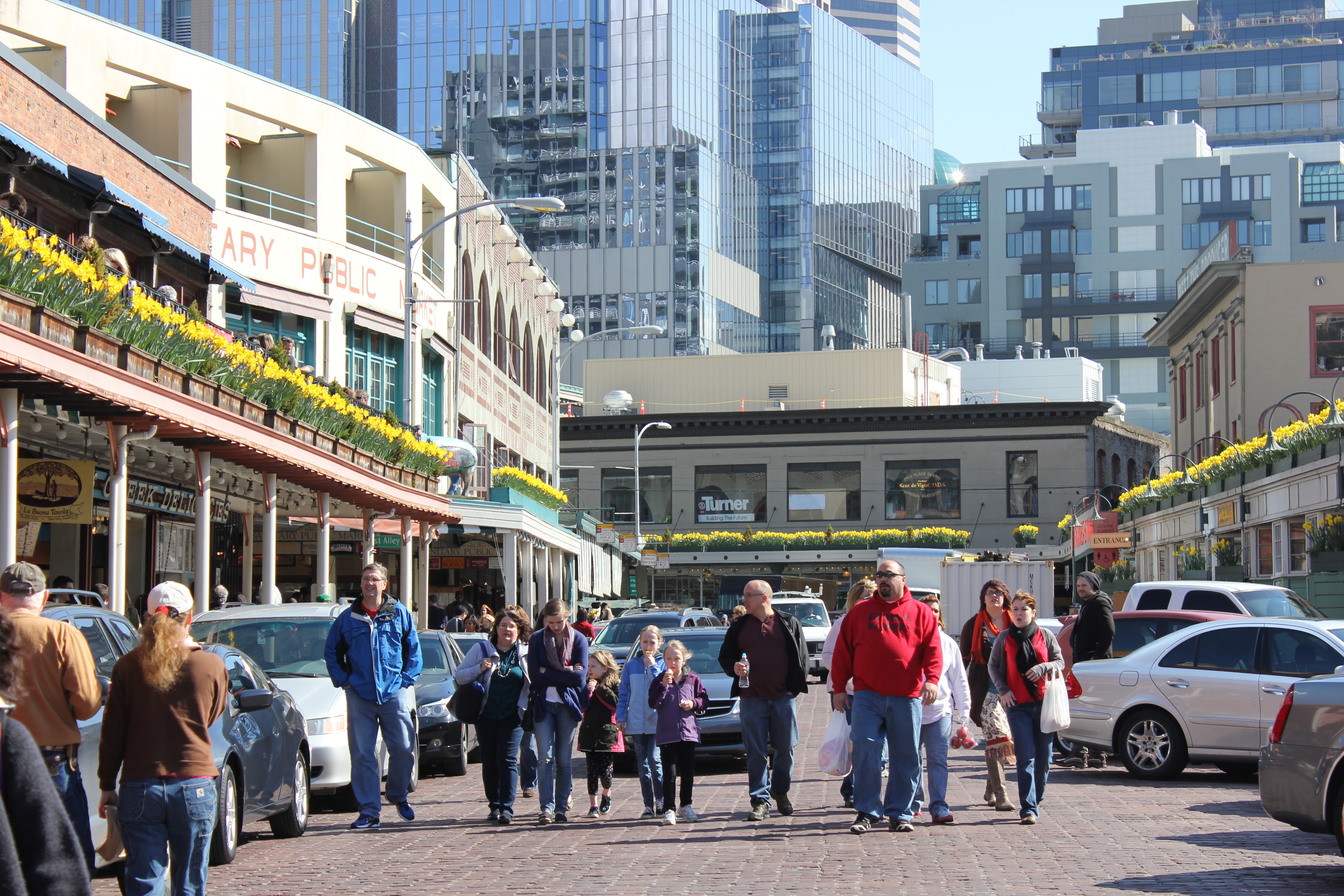Article Note: This is the second installment in a series on observations of people in Pike Place. See Part 1 for a brief background of public life studies, and observations of the existing design features and transitory activity at Pike Place. This part focuses on stationary activity.
As discussed in Part 1, observing people’s behavior, is valuable for understanding how people use public space and relate to the design of the built environment. As one of the most popular places in Seattle, a series of short observational studies were conducted at Pike Place to gain a better understanding about the design of the public space and people’s experiences, particularly where they move and stay. This part focuses on observations of people’s stationary activity, where they sit and stand, in Pike Place.
Pike Place Study
Methodologies developed by Jan Gehl and Birgitte Svarre in How to Study Public Life (2013) were adapted to document pedestrian activity at Pike Place. Part 1 discusses the study area and the techniques used. The data was collected on two weekdays in July 2015. Day 1 of the study was conducted between 11am and 3pm with predominantly overcast and mild conditions. The study was conducted between 2pm and 5pm on Day 2 with sunny and hot conditions.
1. Stationary Activity
The number of people standing and sitting in a public space can provide insight into its quality, as well as the extent to which people feel comfortable or enjoy the experience afforded there. Documenting stationary activity can be helpful for understanding whether there are adequate opportunities and reasons for people to stay and spend time in a place. It is important that public spaces are designed for people to sit or stand to rest, eat, relax or socialize, and so they can enjoy the surrounding atmosphere, architecture, views, amenities or climate.
Approach
A one-directional walk-through of Pike Place was conducted starting at the corner of Pike Street and First Street to the intersection of Pike Place and Virginia Street. To create a snapshot of people sitting or standing, any person observed in the public space ahead was mapped. Observations were only made within the frame of view. In other words, once an area was walked through and documented, any person who sat down or began to stand behind was not documented. Those instances were excluded to avoid overlapping information as the situation changed. The mapped symbols of people sitting and standing were also counted to generate numerical data.
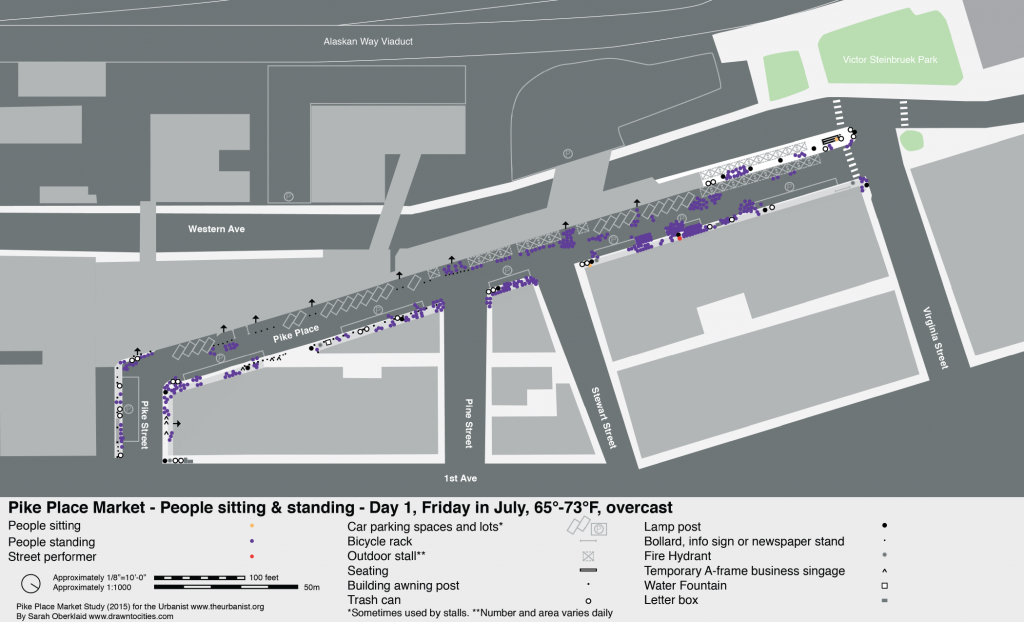
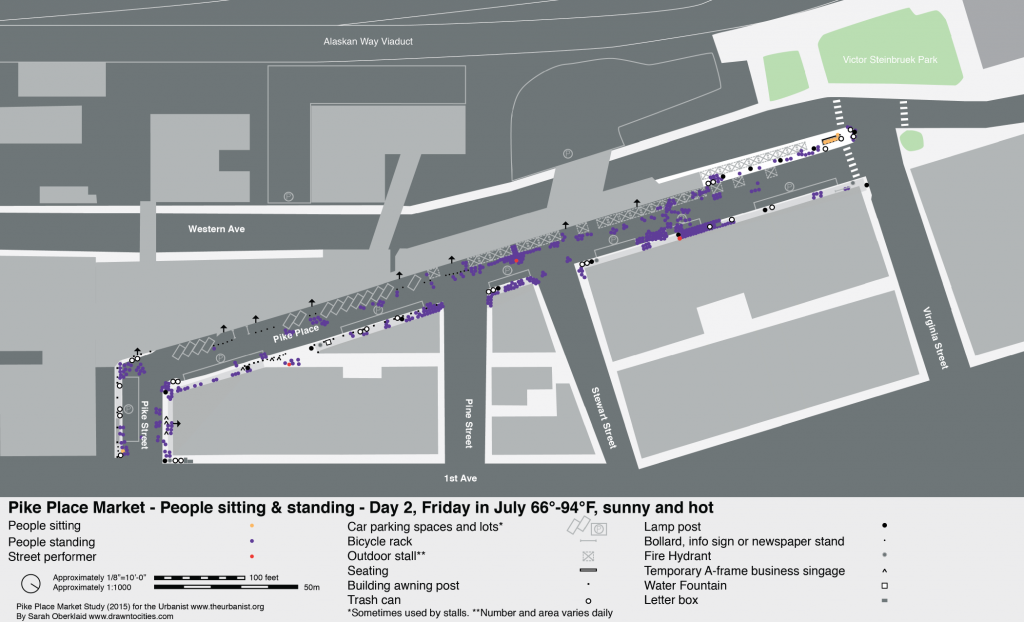
1.1 Mapping and Counting Where People Are Sitting: How many people are sitting and where are they?
Impressions
On both days, very few people were observed sitting in Pike Place at the time of the walk-through. On Day 1, just two people were observed sitting and on Day 2 there were seven. The low numbers of people sitting is possibly due to the absence of accessible seating, other than two benches at the Virginia Street end. While there is a lot of seating along the western end of the Market, this was utilized exclusively by stallholders with no public access on the days of the study. As observed by William H. Whyte in The Social Life of Small Urban Spaces, and referenced in Part 1, people have a tendency to sit where there are places with seating. The few accessible benches may limit the opportunity for people to sit in Pike Place.
However, on both days, immediately after the observational studies, people were seen sitting along the curbs, generally to eat, or if they were part of a group. A few people were also observed sitting on the edge of trash cans. Given that these aren’t necessarily safe, clean, or comfortable places for people to sit, it suggests there is high demand for more accessible public seating in Pike Place. Many people were observed sitting in Victor Steinbrueck Park and Post Alley. The former has many public benches while the latter has a plentiful number of cafe seats and tables, in addition to a handful of public benches interspersed.
On another day in between the studies, the Market had a temporary pop-up cafe with tables, chairs, and umbrellas installed by a vendor to sell food. The pop-up cafe took up a small amount of space on the western side of the street and appeared to be very popular with visitors.
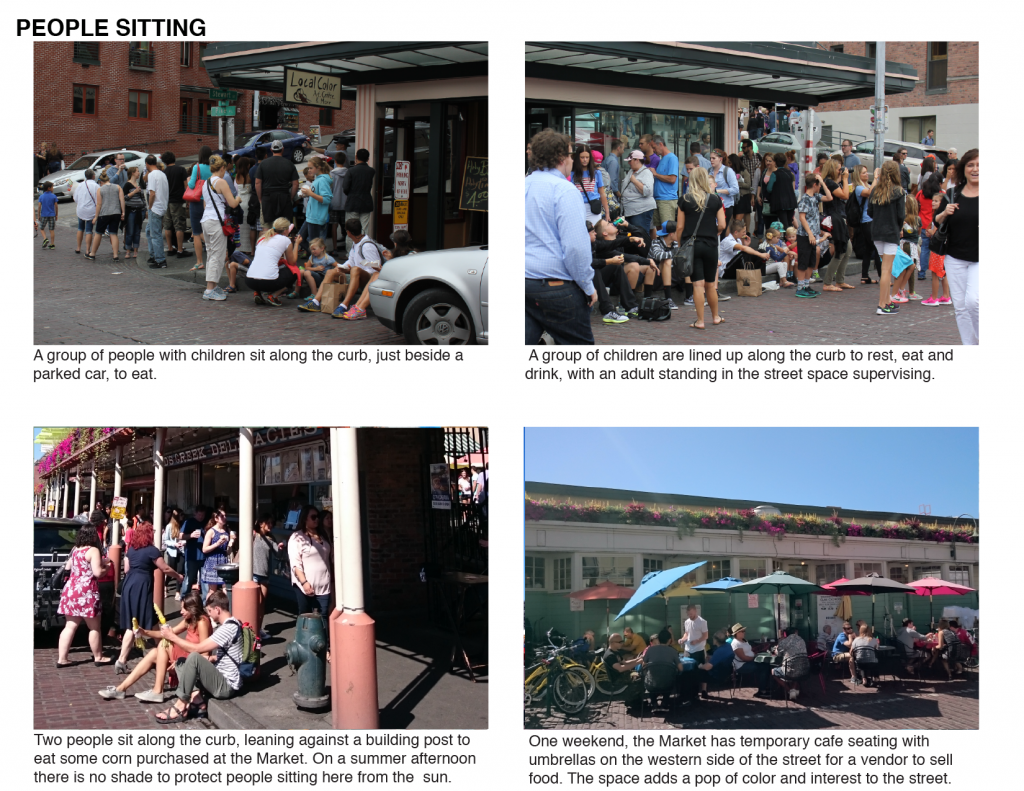
1.2 Mapping and Counting Where People Are Standing: How many people are standing and where are they?
Impressions
On both days, many people were observed standing throughout Pike Place, with 401 people on Day 1 and 469 on Day 2. On the eastern side, people were generally observed standing on the sidewalk or very close by. They were generally observed standing very close to shop frontages. Despite the awnings, on Day 2 they were mostly in direct afternoon sun. The places observed with a large cluster of people standing on the eastern side of the street included:
- The corner of Pike Place and Pike Street;
- Outside Beecher’s Handmade Cheese;
- Outside Piroshky Piroshky; and
- Outside Starbucks.
These locations are shown on the next map.
On the western side, of Pike Place (past the intersection with Pike Street) there is no sidewalk. On this side, the main building has small sections of active frontages, with a mix of car parking spaces and temporary stalls in front. Many people were observed standing on this side of the street, most commonly near the stalls or entrances, rather than the building itself. This side tends to receive more shelter from the sun on a summer afternoon. On this side, people were observed clustered around the:
- Information booth on Pike Street;
- Main building entrances; and
- Outdoor stalls.
Only a handful of people were observed standing in the street or car parking spaces, other than at the north-eastern end, where people were seen standing in the center of the street and bleeding into car parking spaces to listen to street performers (outside Starbucks on both days, and between Pine and Stewart Streets on Day 2).
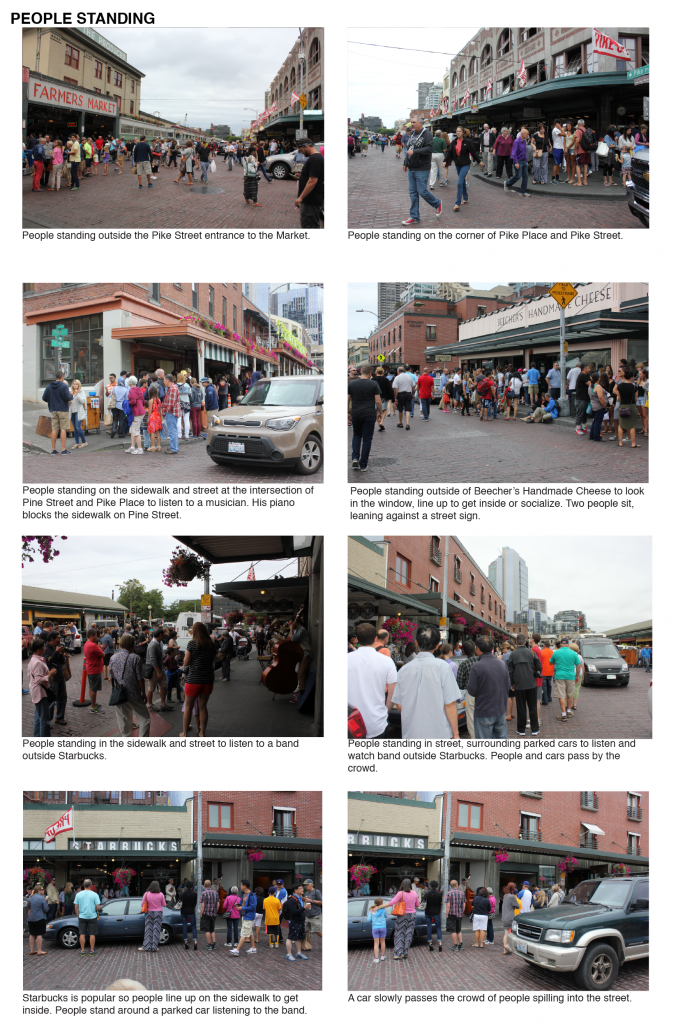
2. Noting Common Activities: What are people doing in different parts of the Market?
Noting the common activities in a particular place assists with understanding why people spend time there and how an area should be best designed to create a people-friendly environment. In How to Study Public Life (2013), Jan Gehl and Birgitte Svarre suggest that activities can be categorized as necessary, optional, or social.
Necessary activities are routine, such as going to work, shopping, running errands, or waiting for a bus. These are influenced to a small extent by the quality offered by the physical environment and occur year round in most conditions. Optional activities are those that someone does because they want to, such as relaxing, walking for pleasure or fresh air, or sitting to read a book. These activities are more dependent upon conditions such as weather and the quality of physical surroundings. Social activities include interactions with others such as playing or having a conversation.
Approach
During a walk through of Pike Place, people’s activities were observed and denoted on a map.
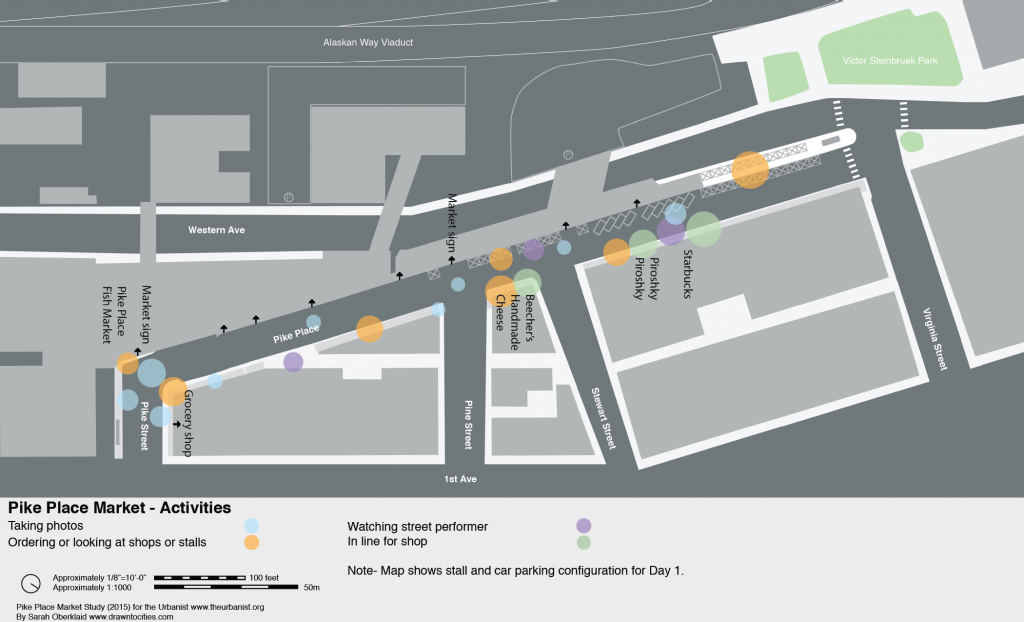
Impressions
Common activities observed at Pike Place provide some insight into why people were walking, sitting, or standing in certain localities. Activities were predominantly optional, with the main necessary activity being shopping. At the Corner of Pike Place and Pike Street, many people were observed taking photos of the neon market sign as well as looking or shopping at the grocery store. At the Pike Street entrance, people frequently stood close to the entrance where they watched the spectacle of Pike Place Fish Market throwing fish. They also took tourist photos here.
Outside Beecher’s Handmade Cheese, a large number of people were watching the cheese making process through the window or lined up for the store, which consumes much of the sidewalk at times. Piroshky Piroshky and Starbucks are extremely popular stores, with many people observed lining up, or looking in the windows. Outside Starbucks, on both Day 1 and Day 2 of the study, approximately 50 people were observed spilling out from the sidewalk into car parking and the street space to watch a street performer.
3. Temporary Reconfiguration
On several weekends over summer, Pike Place Market temporarily reconfigured the public thoroughfare. Half of Pike Place was restricted to traffic with cars only allowed to circulate from Pike Street to Pine Street. At the intersection of Stewart Street, Pike Place had bollards and security which did not allow cars to enter. This had an interesting effect on where people were observed walking, sitting, and standing. At the end with cars, cones were added to the western side of the Market to create a temporary sidewalk. The car-free area enabled people to walk or stand anywhere in the street without concern for traffic or parked cars.
Many people were observed walking or standing in the center. The space featured additional stalls in different places, adding color and interest to the street. Many people were also observed sitting along the curb at different parts of the Market, free from parked and moving cars. As mentioned earlier, Pike Place Market also installed cafe seating with umbrellas for a particular vendor, between the Pike and Pine Street entrances, which consumed very little space, but provided a popular place for people to sit and eat.
This temporary redesign by Pike Place Market highlights the flexibility of the street space. Staff made easy changes that allocated space for pedestrians and cars simply through cones, signage, some extra tables, chairs, and stalls. No doubt, such alterations, even just for a few hours or a day, require significant planning and consultation with business owners, but highlight how the space can be configured differently. This approach is commendable as it enables the Market’s management to compare how different allocations of space impact vendors and visitors. It also enables Market management to respond to differing conditions as need (e.g. busier weekends over summer or quieter days in winter).
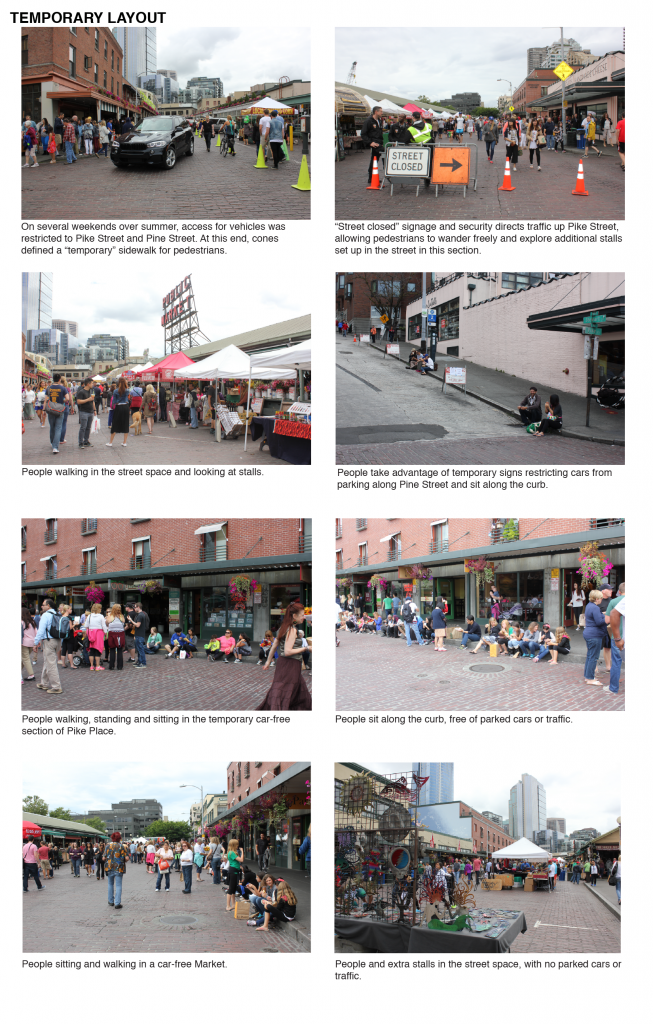
Overall Observations
The observational studies shared in Part 1 and 2 highlight the successfulness of Pike Place. It is an incredibly popular public thoroughfare with high pedestrian volumes. The documentation of people’s key movements and places they commonly sit or stand merely touches the surface of the complexity and diversity of activities in the Market precinct. The studies provide some insight to the interactions between people and the design qualities of Pike Place.
Although on the days of the study, few public benches were accessible and few people were observed sitting, there may be high demand for seating. On subsequent walk-throughs of Pike Place, many were seen seeking informal and resourceful places to sit to eat or rest, particularly along the curbs. It is possible, that some people would not choose to sit in the gutter if they were aware of more accessible seating within Pike Place, or directed to benches at Victor Steinbrueck Park via signage. The temporary cafe seating installed by Pike Place Market on several weekends over summer, appeared to be extremely popular. This demonstrated that the street space has flexibility to successfully accommodate additional small pockets of temporary or permanent seating, with limited impact on parking or traffic circulation.
As observed in Part 1, many people walk on the sidewalks, however some sections are cluttered with street furniture, and as observed in Part 2, several areas are very popular for people to stand. There are several sections of sidewalk that appear to experience congestion, which causes some people to spill into car parking spaces and the street space. It is important for further research to explore interactions between pedestrians and cars, particularly at these points, to ascertain if this presents safety or comfort issues. The temporary reconfiguration of pedestrian and vehicular access on some weekends over summer, demonstrates the potential for simple interventions. Under these conditions, people were observed to make greater use of the street space, walking through the center. The demarcation of a pedestrian space on the western side provided an extra area where people could walk easily without impeding, or being impeded by cars. It would be interesting to conduct research to find out the impacts of these temporary interventions including the extension of stalls and outdoor cafe spaces into the street, on visitors to the market and stall holders.
The studies show the Market is an incredibly successful place, attracting a high number and diversity of people. Observing the way people occupy public spaces helps us to reflect upon the current design features and to consider opportunities to further foster people’s enjoyment and the time they spend in a place.
Sarah is an urban planner and artist from Melbourne Australia, currently living in Seattle. She has contributed to diverse long-term projects addressing housing, transportation, community facilities, heritage and public spaces with extensive consultation with communities and other stakeholders. Her articles for The Urbanist focus on her passion for the design of sustainable, inviting and inclusive places, drawing on her research and experiences around the world.

